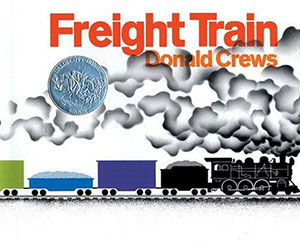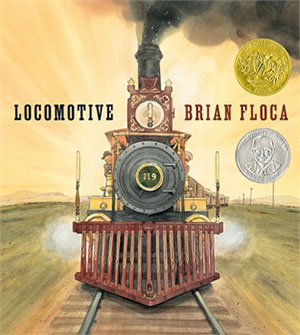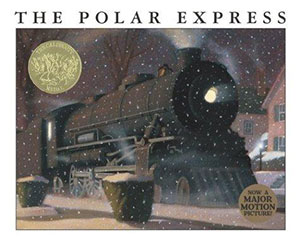“Everyone has trains in their lives,”1 maintains picture book author and illustrator Donald Crews. While few children have ridden a passenger train, their interest is fueled by watching video series, playing with train sets, and counting train cars at a railroad crossing. The following Caldecott Award books consider trains from different vantage points, from the outside or inside, from a real or fantastical world. Climb aboard!
The vehicle is the protagonist in Donald Crews’s 1979 Caldecott Honor book Freight Train. Along the bottom of the title page and copyright/dedication pages runs an empty train track in neutral hues on a stark white background. The first spread pronounces, “A train runs across this track.” yet the track remains empty, instilling anticipation. A page turn begins a sequence of double-page spreads as the reader approaches the train from the rear: the bright warm colors of the last three cars of the track; then the cool colors of the next three cars; and in the lead, the black tender steam engine, emitting smoke. The following spread is a long shot of the entire train, heralding its rainbow of cars.
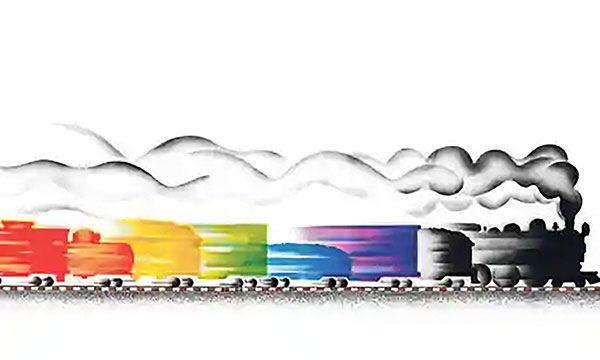
This perspective is retained throughout the book as the train speeds forward in a blur of colors through tunnels, past cities, and over trestles in a well-paced 24-page journey. The last three pages leave readers breathless as the train travels in darkness, then daylight, before racing off the page – “gone,” leaving only wisps of smoke.
In a minimalistic style, the few backgrounds are muted, giving readers a sense of place while keeping the focus on the train. The combination of crisp lines and shapes, colorful blurring cars, and billowing black and grey smoke are achieved through preseparated art and airbrush with transparent dyes.2
Crews’s connections to trains run deep. His father worked for the Pennsylvania Railroad, which gave the family free passage for their yearly summer trips from New Jersey to his maternal grandparents’ farm in Florida.3 In fact, the book’s dedication includes a nod to “the countless freight trains passed and passing the big house in Cottondale.” Crews’s personal association with trains, in concert with his adept design skills, create delight in this successful picture book for young children.
Unlike Crews’s conceptual train book, Brian Floca’s 2014 Caldecott Award book Locomotive is infused with history, specifically that of the transcontinental railroad. The storyline of the picture book is disclosed on the title page, where a vignette introduces a fictional family. A telegraph from Papa beckons his wife, daughter, and son to travel from Omaha to join him in California. A family photo and two railroad guides complete the tableau.
Before their journey begins, the book opens with an image of the austere landscape, followed by a double-page spread acknowledging the workers who built the railroad. On the recto, swinging hammers lead to the page turn.
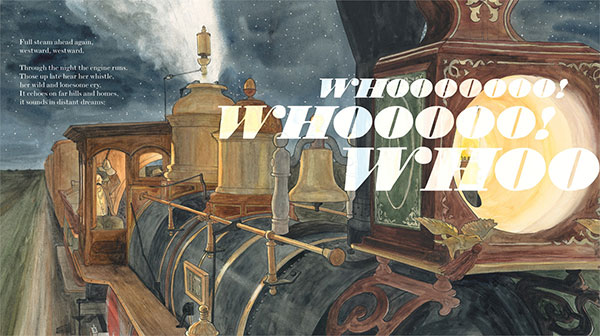
The mother and children wait on the platform as the massive train arrives. In text and illustrations, Floca describes the responsibilities of the crew members, as well as passenger amenities available on the train, such as a stove for heat and a toilet. Along the way, the engines and crews are replaced during the four-day adventure. Specific geographic landmarks signal the train’s westward progress, including Castle Rock in Utah and the Forty Mile Desert in Nevada. Sacramento marks the end of the train’s journey and the beginning of a new one for the reunited family, who continue by steamer to San Francisco.
Floca deftly employs ink with watercolor, acrylic, and gouache in his realistic paintings. The images of the train, particularly the immense locomotives, are surprisingly colorful and ornate. In many spreads, the locomotive charges directly at readers. Nighttime scenes mesmerize with the glow of interior and exterior train lamps and starry skies.
Page design varies widely from small and large vignettes to full-bleed single- and double-page spreads in the large format, 64-page picture book. Bold and varied typefaces play an active role in the composition of many illustrations, often to accentuate loud noises.
Floca, a college history major, admits that the topic “sprawls. It’s history, it’s engineering, it’s the landscape, it’s the West!”4 He examines these elements in depth in the dense front endpapers which include a reproduction of a Union Pacific Railroad advertisement touting the newly completed route, topographical and elevation maps, and a historical overview of the rail line. Extensive back matter describes the impact of the steam locomotive and Floca’s sources. Finally, back endpapers explain the science of steam power, complete with a detailed cross-section of a steam engine. A Central Pacific Railroad timetable and fare listing hides beneath the dust jacket flap.
A final picture book takes readers on a wondrous winter train ride in a contemporary children’s classic conceived by author-illustrator Chris Van Allsburg. In the 1986 Caldecott Medal book The Polar Express, a boy holds out hope that he will hear the ringing Santa’s sleigh bells on Christmas Eve. Instead, he hears the hissing and squeaking of a train that has stopped in front of his house. In pajamas, robe, and slippers, the child ventures outside, where he is greeted by the conductor of the Polar Express. Naturally, the boy climbs aboard to embark upon an extraordinary journey. The long train, filled with children, travels through forests and over mountains before it crosses the polar ice cap to a city at the North Pole.
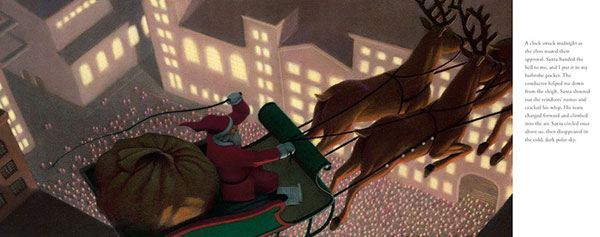
Van Allsburg’s framed images cover almost an entire double-page spread, leaving room for a narrow margin of text on the verso or recto. Within each illustration the artist uses a range of muted blues, taupes, reds, and yellows, playing with dark and light to set the mood, often magical but sometimes ominous. Warm lights from the train windows and within the city are countered by mysterious shadows. Snow and steam enhance the dreamlike quality of the story. The artist’s realistic and surrealistic illustrations are detailed, with lines softened by his use of full-color oil pastels on pastel paper.5
The illustrator shifts the point of view throughout the book, thereby maintaining visual interest and creating surprise. Until the train reaches its destination, it remains the focal point, changing in size and location on each spread. The sequence of scenes at the North Pole are noteworthy, with long views and close-ups, looking up from below and looking down from above. The image of Santa flying off with his team of reindeer is dizzying. The artist addresses his cinematic approach to illustration: “Because I see the story unfold as if it were on film, the challenge is deciding precisely which moment should be illustrated and from which point of view.”6 Van Allsburg’s enticing illustrations draw readers into the tale, a story that seems improbable, but just might be true.
In a variety of styles for a wide range of readers, these Caldecott Award books capture the allure of trains through appealing narrative and distinguished artwork.
Picture Books Cited
Crews, Donald. Freight Train. New York: Greenwillow, 1978.
Floca, Brian. Locomotive. New York: Atheneum Books for Young Readers, 2013.
Van Allsburg, Chris. The Polar Express. Boston: Houghton Mifflin, 1985.
Notes
- Leonard S. Marcus, Pass It Down: Five Picture-Book Families Make Their Mark (New York: Walker, 2007), 10.
- Association for Library Service to Children (ALSC), The Newbery & Caldecott Awards: A Guide to the Medal and Honor Books (Chicago: American Library Association, 2017), 127.
- Donald Crews, “Wilder Medal Acceptance,” Horn Book Magazine 91, no. 4 (July 2015): 89.
- Julie Danielson, “Epic, Intimate Locomotive,” Kirkus Reviews, 16 September 2013.
- ALSC, The Newbery & Caldecott Awards, 121.
- Chris Van Allsburg, “Caldecott Medal Acceptance,” Horn Book Magazine 62, no. 4 (July 1986): 423.
Bibliography
Association for Library Service to Children (ALSC). The Newbery & Caldecott Awards: A Guide to the Medal and Honor Books. Chicago: American Library Association, 2017.
Crews, Donald. “Wilder Medal Acceptance.” Horn Book Magazine 91, no. 4 (July 2015): 88 – 94.
Danielson, Julie. “Epic, Intimate Locomotive.” Kirkus Reviews. 16 September 2013.
“Marcus, Leonard S. Pass It Down: Five Picture-Book Families Make Their Mark. New York: Walker, 2007.
Van Allsburg, Chris. “Caldecott Medal Acceptance.” Horn Book Magazine 62, no. 4 (July/August 1986): 420 – 24.

